This post will teach you how to make a beginner sourdough starter at home, step-by-step. All you need is flour, water and a little bit of patience. Before you know it, you’ll have your very own bubbly, active sourdough starter to make my best sourdough bread recipe, sourdough focaccia and more! Grab your personal sourdough starter feeding chart.
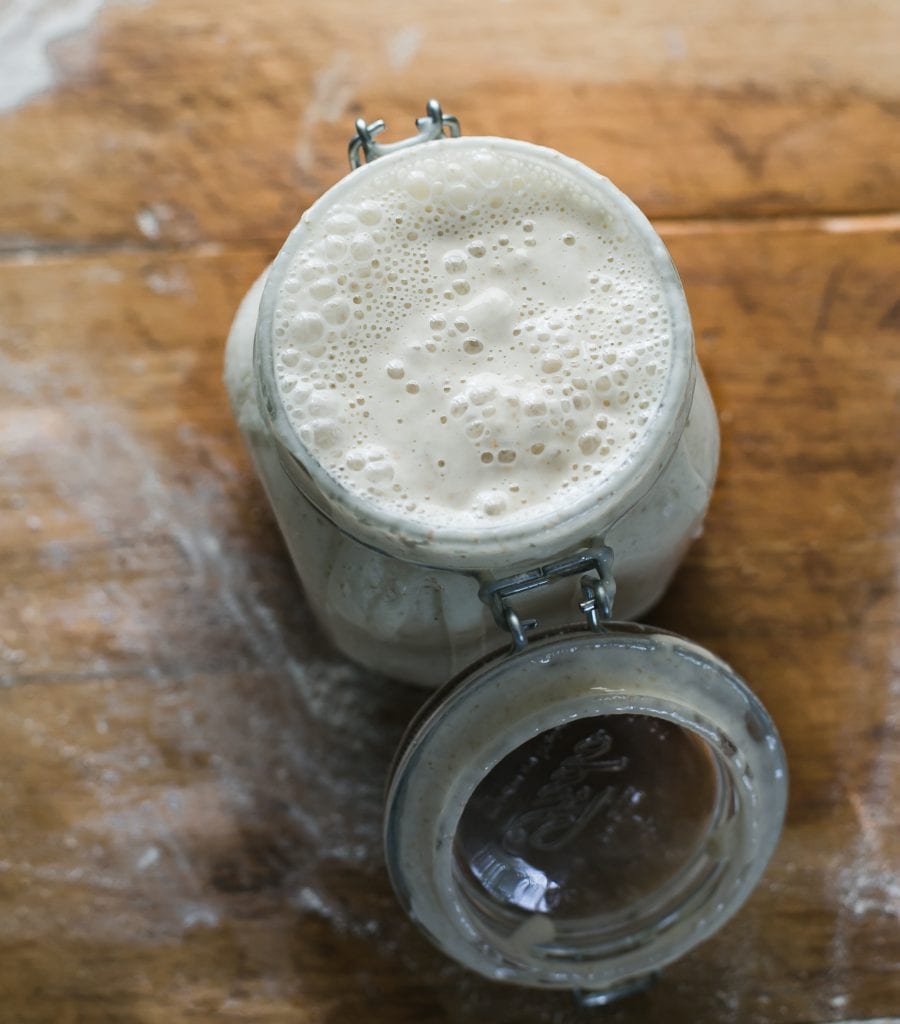
Looking to bake sourdough bread? First: you’ll need a sourdough starter. Without it, your bread won’t rise. It’s the absolute heart and soul of sourdough baking. Creating a sourdough starter from scratch is not hard to do. However, the process is intimidating, especially for beginners. Let’s change that.
Adapted from my bestselling book Artisan Sourdough Made Simple, I will demystify and simplify the process with step-by-step recipe instructions. In approximately 7+ days (yes, it takes that long- there are no shortcuts) you’ll get approximately 1 cup of bubbly, active sourdough starter which is more than enough to make bread, including my best sourdough bread recipe with olive oil (most popular recipe on my blog!). More sourdough bread recipes here.
Sourdough is more than just a recipe; it’s an understanding. So before we dive in, let’s define.
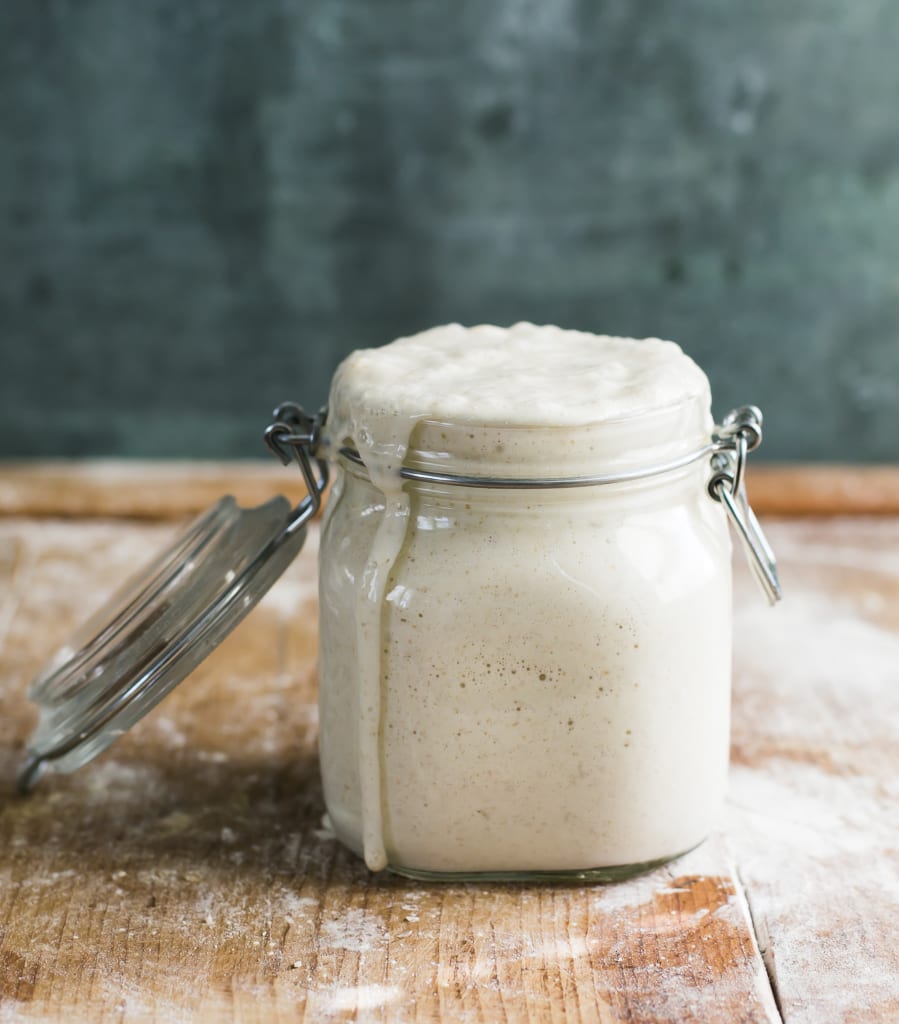
What Is Sourdough Starter?
A sourdough starter is a live, fermented culture of flour and water filled with wild yeast and bacteria from our environment. A small portion is added to sourdough bread dough to make it rise. Commercial yeast IS NOT required.
Sounds a bit weird, right? Of course it does. Know this: natural “wild” yeast is all around us. It can be found in a bag of flour, in the air, on your hands etc. Just because you can’t see it, doesn’t mean it’s not there and doing its thing. It’s like magic.
How Long Will It Take?
To create a sourdough starter from scratch, the overall process will take 7 days (or more) from start to finish. It’s not instant. First, you’ll create the starter with whole wheat flour to jumpstart fermentation. Then, you’ll continue to feed it with regular all purpose flour or bread flour to cultivate the wild yeasts and friendly bacteria. Once it’s created, you’ll keep it alive with ongoing feedings and care, which you can read about here.
When Will It Be Ready To Use?
Your starter is ready to use when it has doubled in size, with plenty of bubbles on the surface and throughout the culture.
NOTE: It’s not uncommon for it to take up to two weeks or more for the starter to become active. It all depends. I know this timeframe sounds a bit vague, but growing yeast in a jar (that’s basically what you’re doing) can be unpredictable at times. Please be patient if the process takes time for you- it’s normal.
Is It Difficult To Do?
Absolutely not! In short: you’re basically adding flour and water to a jar, feeding it with more flour and water and waiting for it to become bubbly, active and double in size. That’s it. Most of your time involvement is hands-off. Can I ask you a favor though? Don’t overthink it. There’s a ton of sourdough information out there, and you will fall down a major rabbit hole if you start poking around. Just stick to this tutorial for now, follow the steps as written and just go for it.
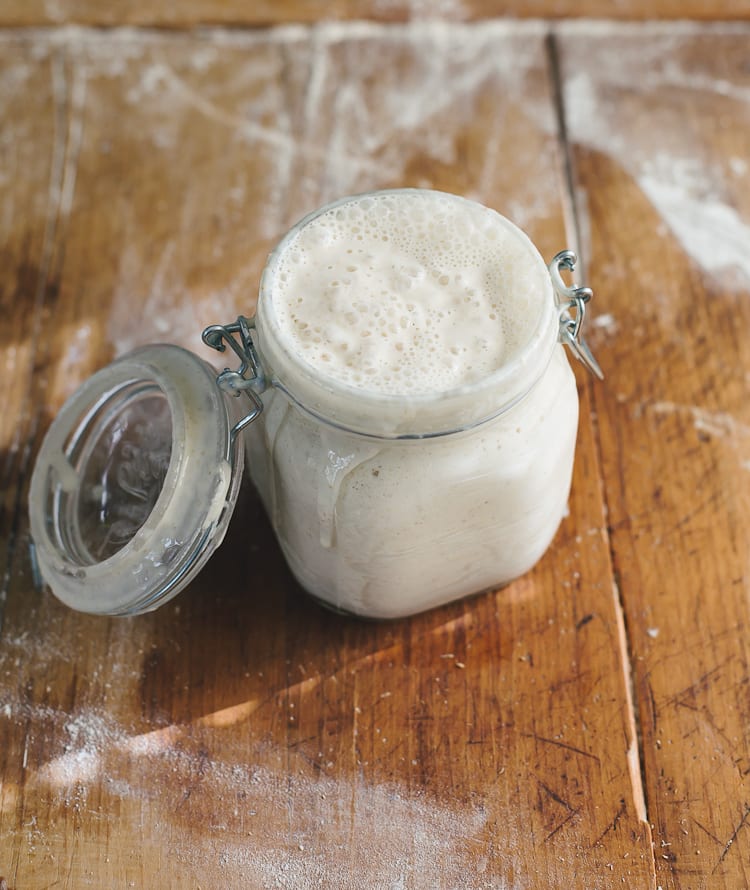
Beginner Sourdough Starter Recipe {Step-By-Step}
You Will Need:
Supplies
- 3/4 L jar (I use this one)
- Digital scale
- Small rubber spatula
Ingredients
To create the sourdough starter on Day 1:
- 60 g (1/2 cup) whole wheat flour
- 60 g (1/4 cup) water
To feed the sourdough starter each day (Days 3-7):
- 60 g (1/2 cup) unbleached all purpose flour or bread flour
- 60 g (1/4 cup) water
NOTE: Use regular, unbleached all purpose flour or bread flour for best results. I use flour from KAF, Trader Joe’s or Whole Foods. As for organic flour, I first learned that it wasn’t always successful when first creating a sourdough starter (sourdough can be finicky). However, due to the widespread use of glyphosate, I’ve been inspired to re-test with organic flour. The results were good. Please experiment with what resonates. For the water, filtered or tap water is fine. Use the latter if you know it’s mostly chemical/chlorine free.
Day 1: Make The Sourdough Starter
- First, download and print out this chart. It’s your daily “at a glance” feeding schedule to keep you on track.
- Add 60 g (1⁄2 cup) of whole wheat flour and 60 g (1⁄4 cup) of water to your sourdough starter jar. Total yield: 120 g sourdough starter.
- Mix with a fork until smooth; the consistency will be thick and pasty.
- Cover with plastic wrap or a lid, and let rest in a warm spot, about 75 F for 24 hours.
Temperature Tips: Temperature is very important. If it’s too cold, your starter won’t rise and the process will take longer. Consider the following tips if you’re looking for a warm, 75 F spot. Place your starter on a cookie sheet inside the oven (turned off) with the light on for a only few hours to give it a boost (please don’t leave it there overnight- the environment will become too warm). Monitor the temperature with an oven thermometer. You can also use a proofing box set to your desired temperature, or a microwave with the door ajar and the light on.
Day 2: Got Bubbles?
- Today, you’re going to check if any small bubbles have appeared on the surface.
- Bubbles indicate fermentation, which is what you want. However, it’s okay if you don’t see anything right away; the bubbles might have appeared and dissolved overnight while you were sleeping. This happens quite often.
- You do not have to do anything else on Day 2. Just let it rest in your warm spot for another 24 hours. Feel free to stir once or twice to oxygenate the mixture.
Tip: What’s That Brown Liquid? During the creation process, and even after your starter has been established, a dark liquid might appear on the surface (the image below shows the liquid in the middle of the starter). This liquid is called “hooch” and is an indication that your starter is hungry. It also has a very distinct smell, similar to rubbing alcohol or gym socks. This is normal. Don’t freak out. Any time you see this liquid, it’s best to pour it off before feeding it with fresh flour and water.
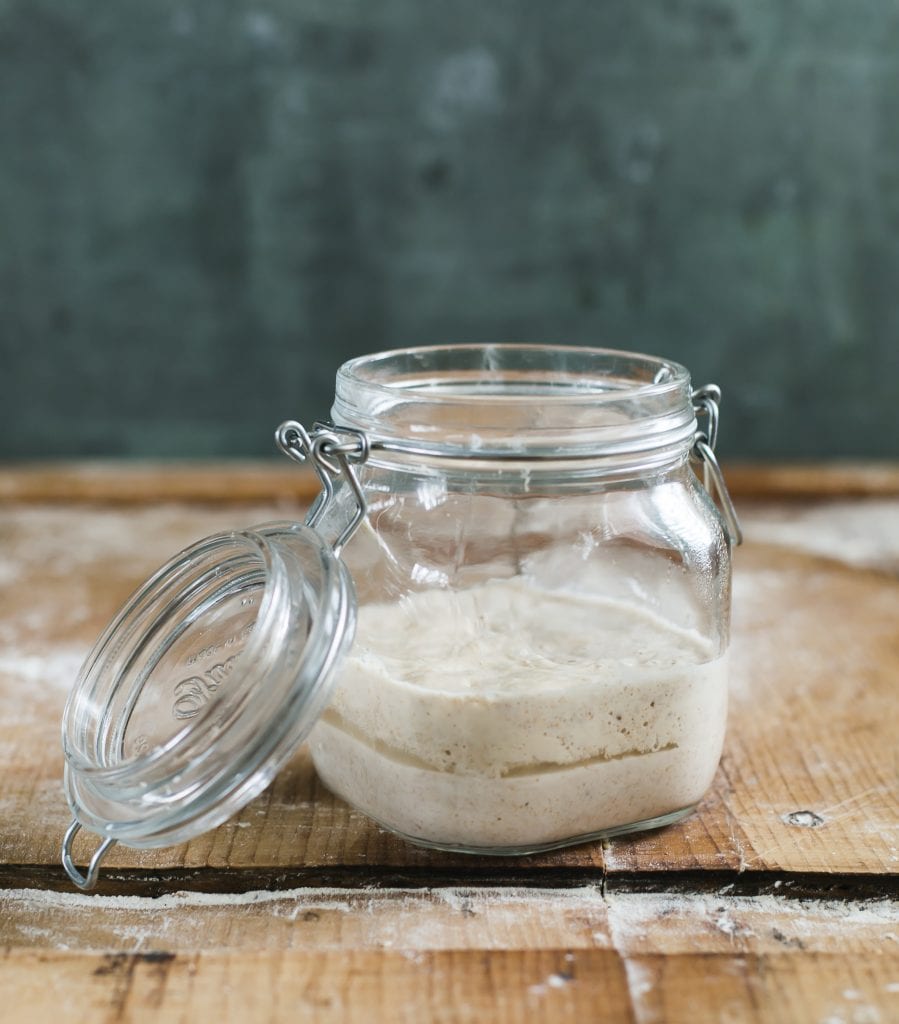
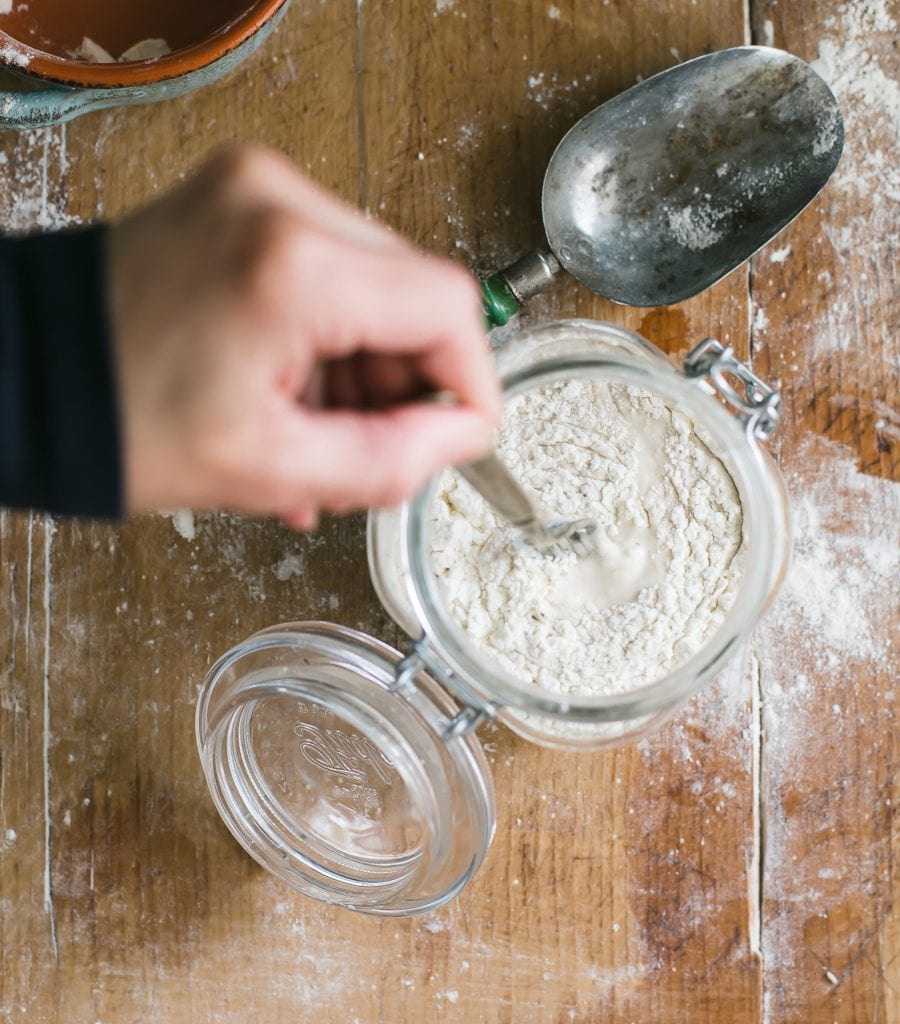
Days 3-7: Feed Your Sourdough Starter
Whether bubbles are visible or not, it’s time to start the ongoing feeding process. As the natural yeasts begin to develop, your starter will rise. Bubbles will form on the surface. Eventually, your starter will fall back down or “collapse” indicating that it’s time to feed it again. The goal: is to increase the total quantity to about 236 g (1 cup) following the specific feeding ratio outlined below on each day.
Before you begin, a few tips for success:
- Establish a feeding schedule. Feed your starter at the same time each day. This will train your starter to rise and fall predictably, which is what you want. Consider feeding your starter in the morning when you wake up. Again, this is where my feeding chart comes in handy.
- Track the growth. Place a rubber band or piece of masking tape around the jar to measure the starter as it rises. When it falls, you’ll see streaks of starter on the sides of the jar.
- Keep your jar clean: Use a small rubber spatula to scrape down the sides of the jar to prevent mold growing up the sides.
- Be patient. This is a slow, gradual process. Remember: temperature (75 F) and consistency (daily feedings @ approximately the same time each day) is key.
Day 3:
- Remove and discard half (60g) of your sourdough starter from the jar. To do so: use a spoon to scoop it out, or pour the starter directly into a bowl to weigh (you can also just eyeball it- the amount doesn’t have to be exact). The texture will be very stretchy.
- To the jar: Add 60 g (1⁄2 cup) of all-purpose flour + 60 g (1/4 cup) of water. Mix with a fork until smooth. Scrape down the sides with a small rubber spatular. The texture should resemble thick pancake batter or plain yogurt at this point.
- Cover and let rest in a warm spot, 70-75 F for 24 hours.
- Total yield: 180 g starter.
Day 4:
- Remove and discard half (90 g) of the sourdough starter.
- To the jar: Add 60 g (1⁄2 cup) of all-purpose flour + 60 g (1/4 cup) of water to the jar. Mix well and scrape down the sides.
- Cover and let rest in a warm spot for 24 hours.
- Total yield: 210 g starter.
- Note: The growth of your starter might appear to slow down on Days 3-4, after switching to all purpose or bread flour for the ongoing feedings. This is normal. Your starter needs more time to adjust. Be patient.
Day 5:
- Remove and discard half (105 g) of the sourdough starter.
- To the jar: Add 60 g (1⁄2 cup) of all-purpose flour + 60 g (1/4 cup) of water. Mix well.
- Cover and let rest in a warm spot for 24 hours.
- Total yield: 225 g starter
Day 6:
- Remove and discard half (112 g) of the starter.
- To the jar: Add 60 g (1⁄2 cup) of all-purpose flour + 60 g (1/4 cup) of water. Mix well and scrape down the sides.
- Cover and let rest in a warm spot for 24 hours.
- Total yield: 232.5 g starter
Day 7:
- Remove and discard half (116.25) of the sourdough starter.
- To the jar: Add 60 g (1⁄2 cup) of all-purpose flour + 60 g (1/4 cup) of water. Mix well, and scrape down the sides.
- Cover and let rest in a warm spot for 24 hours.
- Total yield: 236 g starter
Day 7-8: A Sourdough Starter Is Born!
- By now, your sourdough starter should have doubled in size. You should see plenty of bubbles, both large and small. The texture will now be spongy, fluffy, and similar to roasted marshmallows (think: s’mores). It should also smell pleasant and not like stinky gym socks. If these conditions are met, your starter is now active.
- The very last step is to transfer your sourdough starter to a nice, clean jar. Do this only if your current jar needs a good scrub. Otherwise, leave it as is.
- In keeping with tradition, you can also name your sourdough starter (and please do). My starter is called Dillon after my oldest boy. It’s bright and bubbly, just like him ;)
- Now you’re ready to bake. Start with my beginner sourdough bread recipe- you’re going to love it!
Feeding & Maintaining Sourdough Starter For Ongoing Care
So you’ve created a sourdough starter! Now what? Just like any living creature, your starter must be kept alive with regular feedings, proper storage, and ongoing care to keep to maintain its strength. If your starter is not strong, your bread will not rise. Once you’re starter is established, read my companion article to learn exactly how I do it- Feeding Sourdough Starter: My Best Tips & Tricks. Have more questions? Read troubleshooting your sourdough starter.
Note: You will need to feed your starter every time prior to making bread dough and to maintain it (keep it alive).
How To Store Sourdough Starter
At Room Temperature: If you bake often, let’s say a few times a week, store your starter at room temperature. This will speed up fermentation, making the starter bubbly, active, and ready to use faster. Room temperature starters should be fed one to two times a day, depending on how quickly they rise and fall.
In the Fridge: If you don’t bake that often, store your starter in the fridge covered with a lid. You’ll only need to feed it about once a week or so to maintain its strength when not in use (you can just feed it cold and then pop it back in the fridge right afterwards; no need to warm it up first). When you are ready to make dough, feed your starter at room temperature as needed, to wake it back up.
Frequently Asked Questions & Helpful Info:
1.) Can this sourdough starter be made with all purpose flour only?
Yes. The process might take a little longer.
2.) Can sourdough starter be made with bread flour only?
Yes. Because it’s more “thirsty” than AP flour, add more water if the texture is too thick.
3.) Can this sourdough starter be made with whole wheat, spelt flour or rye flour only?
Yes. Like bread flour, whole grain flour absorbs more water than all purpose flour, so adjust the texture with additional water your starter is too thick.
4.) Can sourdough starter be made with bleached flour?
Yes. But it’s not recommended. The chemicals can throw off the fermentation process. Some readers have reported success, however. Your choice!
5.) Why do you use whole wheat flour in the beginning of the recipe? And then switch to all purpose flour for the ongoing feedings?
Whole wheat flour is used to jumpstart the fermentation process. All purpose flour or bread flour is used for the ongoing feedings because it’s inexpensive, practical and suitable for everyday baking.
6.) On Days 3 & 4, my starter is not as bubbly compared to Days 1 & 2. Growth is slowing down. Why?
As mentioned in question #5, whole wheat flour is used in the beginning to jumpstart fermentation. This is why you saw bubbles right away. When you switch to all purpose or bread flour for the ongoing feedings, growth will inevitably slow down on Days 3-4, as your starter needs time to adjust to the new flour. This is normal. Growth is still happening.
7.) For the daily feedings, you mention to feed your starter “equal parts” flour and water by weight. For example: 60 g (1⁄2 cup) flour + 60 g (1⁄4 cup). But the volume conversions (measuring cups) are not equal. Is this a typo?
No. It’s not a typo. “Equal parts” refers to feeding by weight only. Not measuring cups. Here’s why: different ingredients weigh different amounts based on density. For example 1 cup of flour can weigh anywhere from 125-150 g depending on how it was packed into the measuring cup. 1 cup of water can weigh anywhere between 236-250 g. Because weights are constant, it streamlines the process for accuracy. It is the preferred measuring unit in bread baking. The volume approximates are listed for convenience because not everyone has a scale.
8.) Can I use the sourdough discard from Day 1-7 for something else?
In the beginning, I typically don’t recommend using the discard (it’s usually really smelly and discolored). I recommend using the discard after the starter has been established. However, everyone will have a different experience with this. If it looks good- use it! And yes, you can save it to create a new, separate sourdough starter if you’d like. For more info please read Sourdough Discard 101: Recipes & Faqs Answered.
By signing up, you agree to receive emails from The Clever Carrot. Unsubscribe at any time.
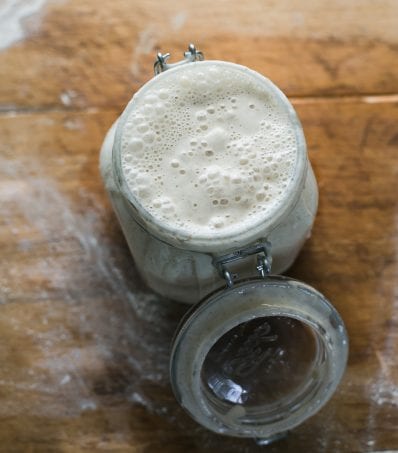
Beginner Sourdough Starter Recipe
- Yield: appx. 236 g (1 cup)
- Category: Sourdough Starter
- Method: 1-Bowl
- Cuisine: American
- Diet: Vegan
Description
Looking for an easy, sourdough starter recipe for beginners? Adapted from my bestselling book Artisan Sourdough Made Simple, follow my no-nonsense, step-by-step guide for practical tips, tricks, and ongoing care- anyone can do it. Use it to make my famous golden, crusty sourdough bread recipe.
Please read my notes below before you begin.
Notes, Tips & Expectations:
- Download & print personal sourdough starter feeding chart {here}.
- The overall process takes ~7+ days, if the temperature is warm enough, ideally 70-75 F. However, it can take up to 2+ weeks or more for a strong starter to become established. Do not ignore the importance of temperature.
- Growth will seem to slow down on Days 3-4. This delay is commonly called a “false” start. It’s also normal- the yeast needs time to cultivate. Please be patient!
- You will need one large 3/4 L jar, or something of similar size (I use this one). Place a rubber band or piece of masking tape around the jar to measure the starter’s growth as it rises.
- To clarify feeding your starter: “equal parts” refers to equal weights only, not measuring cups. Example: 60 g (1/2 cup) flour + 60 g (1/4 cup) water. Same weight. Different volume. Not a typo. Why? Flour is light, fluffy and full of air pockets, so it takes up more space in a measuring cup (but weighs less than water). Water is more dense and compact; it takes up less space but weighs more than flour. That’s why their cup measurements don’t match, even when their weights are identical. Many bakers get confused by this. I’ve included volume measurements for convenience since not everyone owns a scale. But, do choose one measurement system and stick with it for feeding!
Ingredients
Note: Once your starter is established, make your first loaf using my sourdough bread recipe.
- 1x (5lb) bag all purpose flour or bread flour (I use either KAF, Trader Joe’s, or Whole Foods)
- 1/2 cup (60g) whole wheat flour (I use KAF whole wheat)
- Water, preferably warm around 85 F
Instructions
Before you begin: Establish a feeding schedule. Meaning, feed your starter at the same time each day. This will establish consistency, which sourdough starters love. Consider feeding your starter in the morning when you wake up.
Day 1:
- Combine 60 g (1⁄2 cup) of whole wheat flour + 60 g (1⁄4 cup) of warm water in a large jar. Mix with a fork until smooth; the consistency will be thick and pasty.
- Cover with plastic wrap, reusable wax wrap, or a lid and let rest in a warm spot, about 70-75 F for 24 hours. Temperature is important.
- Total approximate yield: 120 g starter
TIP: Looking for a warm, 75 F spot? Place your starter on a cookie sheet inside the oven (turned off) with the light on for only 1-2 hours (it can get hot in there, so keep you eye on it!). Center rack is best. You can also use a proofing box set to your desired temperature, or a microwave with the door ajar and light on.
Day 2:
Check to see if any bubbles have appeared on the surface. If you don’t see anything, it’s okay. The bubbles might have appeared and dissolved overnight while you were sleeping. Feel free to stir once or twice to oxygenate the mixture. Otherwise, you don’t have to do anything else now. Rest the starter for another 24 hours.
TIP: During the creation process, and even after your starter has been established, a dark liquid might appear on the surface and throughout the culture. It has a very stinky smell, similar to rubbing alcohol or gym socks. This liquid is called “hooch” and is an indication that your starter needs to be fed. It’s normal. Any time you see this liquid, it’s best to remove it along with any discolored starter present.
Day 3:
- Remove and discard half (60g) of your sourdough starter from the jar. To do so: use a spoon to scoop it out, or pour it directly into a bowl to weigh (you can also just eyeball the amount- it doesn’t have to be exact). The texture will be very stretchy.
- To the jar: Add 60 g (1⁄2 cup) of all-purpose flour + 60 g (1/4 cup) of water. Mix with a fork until smooth. Scrape down the sides with a small rubber spatular. The texture should resemble thick pancake batter or plain yogurt at this point.
- Cover and let rest in a warm spot, 70-75 F for 24 hours.
- Total yield: 180 g starter
Day 4:
- Remove and discard half (90 g) of the sourdough starter.
- To the jar: Add 60 g (1⁄2 cup) of all-purpose flour + 60 g (1/4 cup) of water to the jar. Mix well. Scrape down the sides.
- Cover and let rest in a warm spot, 70-75 F for 24 hours.
- Total yield: 210 g starter
Note: The growth of your starter might appear to slow down on Days 3-4, after switching to all purpose or bread flour for the ongoing feedings. This is normal. Your starter needs more time to adjust. Be patient.
Day 5:
- Remove and discard half (105 g) of the sourdough starter.
- To the jar: Add 60 g (1⁄2 cup) of all-purpose flour + 60 g (1/4 cup) of water. Mix well. Scrape down the sides.
- Cover and let rest in a warm spot, 70-75 F for 24 hours.
- Total yield: 225 g starter
Day 6:
- Remove and discard half (112 g) of the sourdough starter.
- To the jar: Add 60 g (1⁄2 cup) of all-purpose flour + 60 g (1/4 cup) of water. Mix well. Scrape down the sides.
- Cover and let rest in a warm spot, 70-75 F for 24 hours.
- Total yield: 232.5 g starter
Day 7:
- Remove and discard half (116.25) of the sourdough starter.
- To the jar: Add 60 g (1⁄2 cup) of all-purpose flour + 60 g (1/4 cup) of water. Mix well. Scrape down the sides.
- Cover and let rest in a warm spot, 70-75 F for 24 hours.
- Total yield: 236 g starter
Day 8:
When your starter is fully active, do the float test. Feed your starter, wait for it to double in size, and then drop a teaspoon of bubbly starter into a jar of water; if it floats to the top it’s ready to use.
Storage Options
If you bake often, store your starter at room temperature (feed it 1x-2x a day to keep it active). If you plan to bake only once in a while, store it in the fridge to preserve its strength (feed it 1x a week). When storing your starter in the fridge, there’s no need to bring it to room temperature first before feeding it. Just give it some flour and water and pop it back in the fridge.
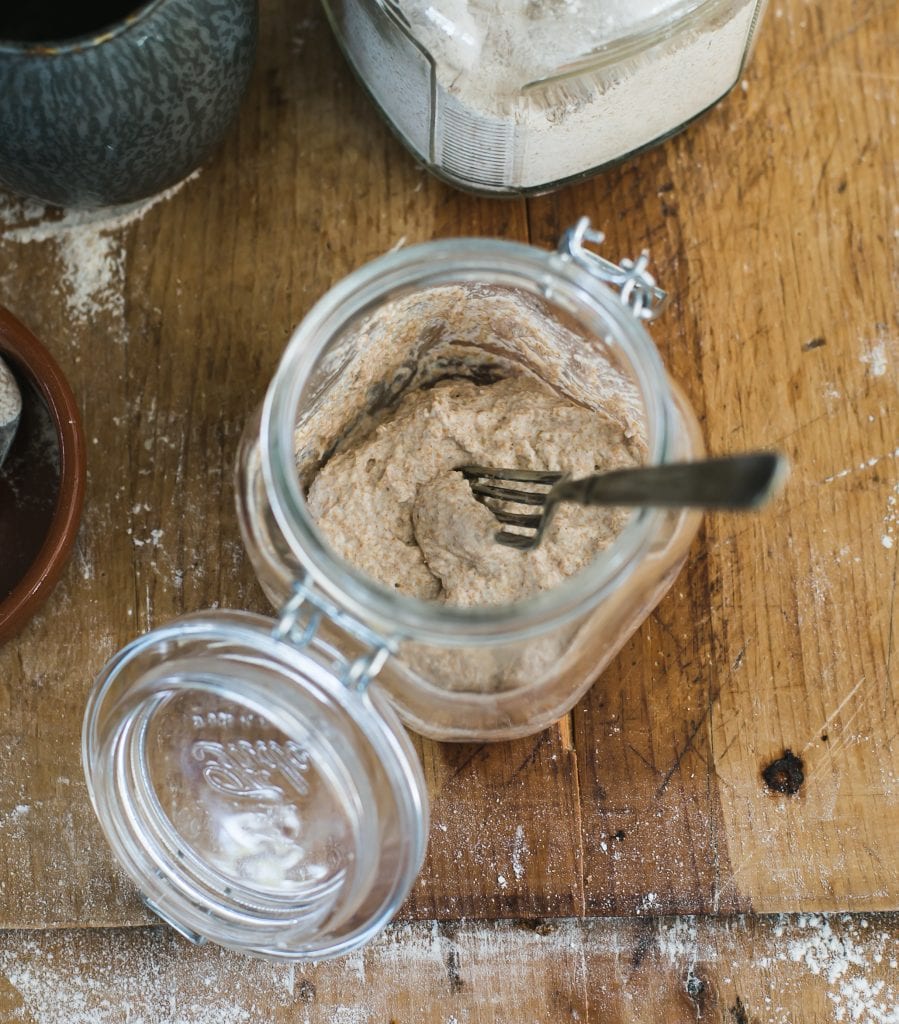
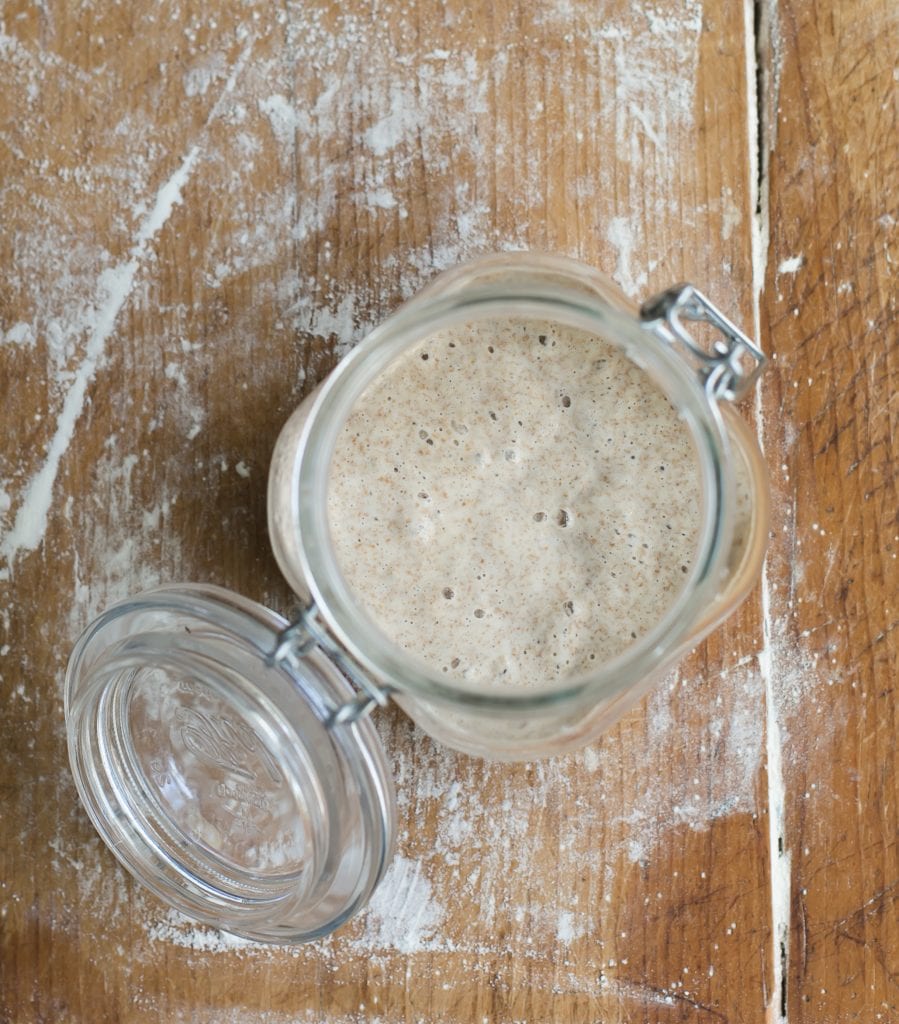
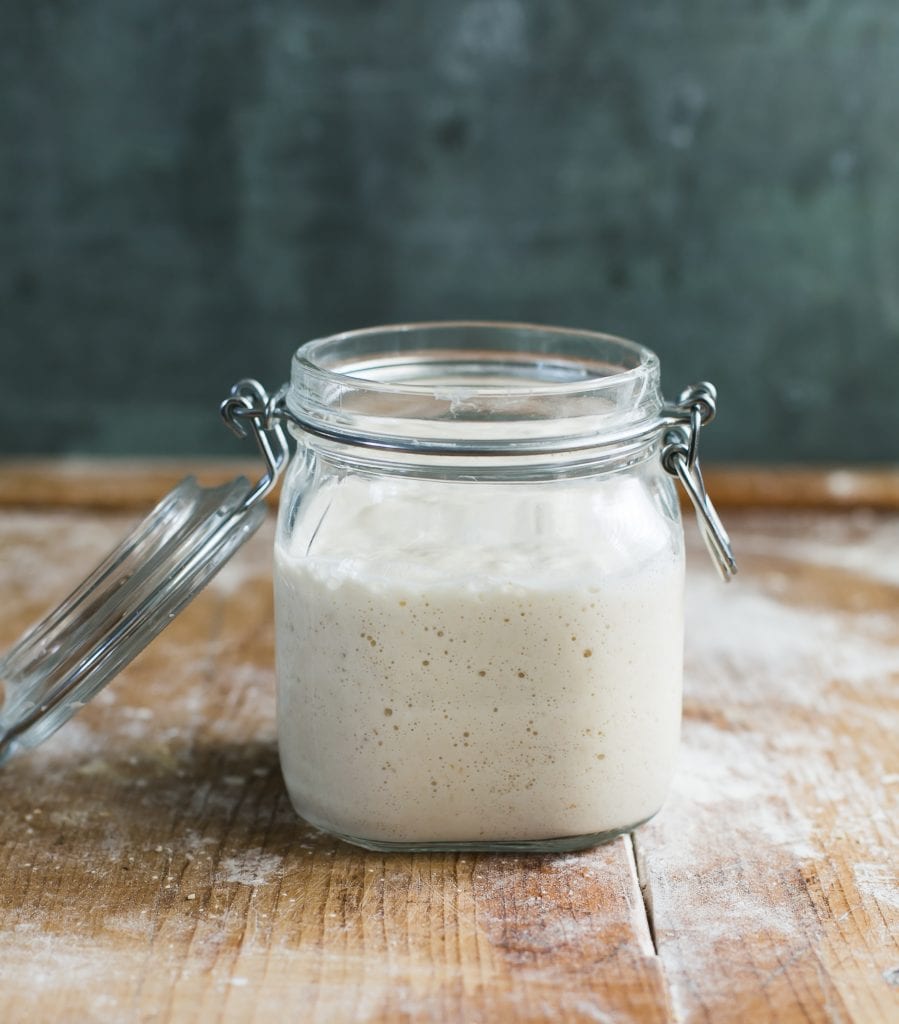
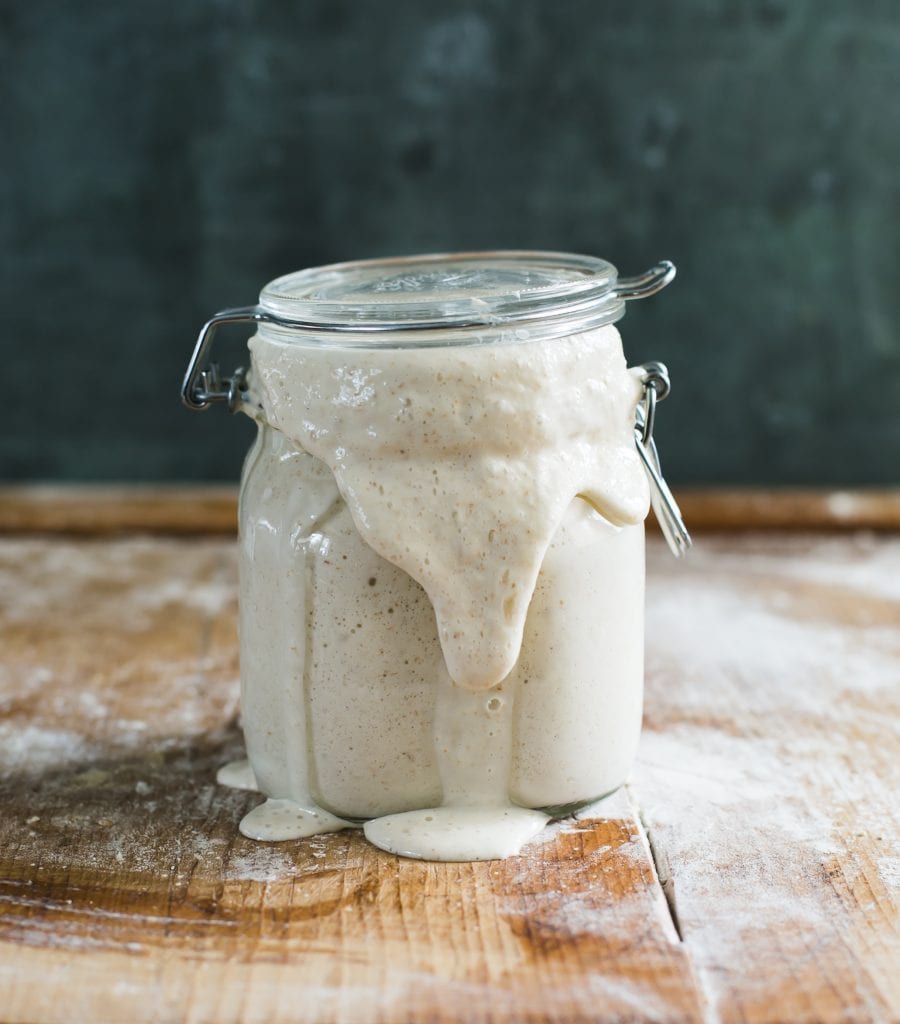
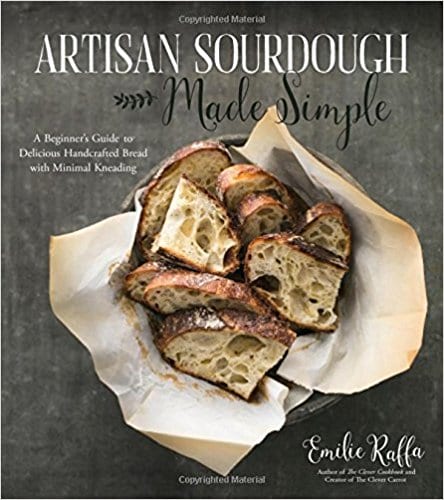


Comments
Becki Porter says
I’ve used nearly all my starter for a recipe but there was probably about 2 tablespoons left. I’ve fed it with the usual 1/2 cup flour and 1/4 water as per the recipe and mixed, leaving it in a warm place to effectively start again. Was this right or should I have just washed the jar thoroughly and started completely brand new? My thinking was at least a bit of the starter could mix with the new feed
Aisha says
Hi, how did your bread come out
Alixie says
Hi!! I’m trying to reactivate a starter. I got some from my dad, and I’ve fed it a few times, I’ve had it for a year or two… and I’ve never made bread with it. I discarded and fed it, it doubled overnight. I tried the float test, it sank immediately. Do I just discard and feed again? Then let it grow, and then go from there?
Gaby H. says
Hi there! I’ve been following the steps closely and I’m in the 8th day. My starter has grown only like 10%… i can see bubbles but is not doubling the size… i started with whole weat and feedings with bread flour, keeping temp 75-76F …. should I be doing something else?
Dave says
Thank you for this clearly written and informative post!
My starter was fed yesterday morning, approximately doubled in volume, and then was left unattended overnight. I intend to use it once this week to make your cinnamon roles. Should I discard, feed it, and then return it to the fridge until later this week, or can I just put in the fridge as is and take it out when needed?
Thanks again for providing these delicious and easy-to-follow recipes!
Jenny says
Hi! I started yesterday but mine isn’t pasty. It just looks like a big, dry solid ball of dough. :/ Should I restart? I used .5 cup of whole wheat flour and .25 cup of water. It just seems much drier than the pic.
Shannon says
I’ve been following this recipe and the first 3-4 days it was doubling and bubbling but I’m on day 10 (and switched to 12 hour feedings) and that’s not happening anymore. There’s a slight rise at best. On day 6 it was big and bubbly and doubled but it was midnight so baking wasn’t practical and it hasn’t done it since. My apartment has been pretty consistently between 71-75 degrees. But the temp has been going up today.
Do I need to start over? Or just keep going?
Mallory says
I am currently on day 3 and I by accident assumed that 60g flour is the same as 60g water and I added 1/2 cup of water to my start. I am using bread flour so hoping it won’t affect it too much since bread flour is a bit more “thirsty”. Can you confirm that I’ll be all set? Or should I start over?
Beve says
Woke up to day 5 and was so excited to see more bubbles and an inch rise! Just did day 5! Can’t wait for tomorrow and eventually giving her a name! 💖💚💛
Bhumika jain says
I am ready with my starter on day 8. I have few questions as I am first time bread baker –
1. I will now bake a bread using your recipe and take out lot of starter from this. Should I just keep the remaining amount in fridge for now?
2. When I feed it next week, how much should I discard before adding 60 flour and 60 water?
Trent Endresen says
Hello I was wondering why my starter is ending up watery I follow the recipe and keep it around 70-80 degrees
Dannie says
I was so excited to try this recipe. I’ve been struggling with sourdough for years and have not been able to make a starter successfully. I’m at day 6 and I do not think this is going to be successful. It’s extremely liquidy, just a couple of bubbles and no rise. It’s been this way for about 2 days. The first couple of days was fantastic I was thrilled. But unfortunately I think this was another flipped starter. Proper flour was used, slightly warm water and a controlled temperature measured with a thermometer ranging around 73-75. I torn between trying again or giving up. Really sad it didn’t work.
Sid C. says
I used this recipe and my starter is ready to use after 5 days! I am so excited! Wish I could send pics here. Thank you!!!
Erin says
Does the wheat flour need to be unbleached? I’m not finding it in any stores. I’m excited to try this!
Julie says
After day 7, if it still needs more time, do i continue with your ratio of 1:0.5:0.5 from day 7? Or do i swap now to 1:1:1. Thank you!
Joyce Delap says
What do you do with the discarded half each time? Can this be made into a second lot of starter.
Nour says
Hi, my first 4 days my starter was doubling in size every night. After day 5, the starter is still very bubbly and has a marshmallow texture but it isn’t doubling in size. I tried the float test but it didn’t pass it. Any recommendations?
Nee says
This is the first sourdough sandwich bread recipe I’ve tried that actually worked perfectly for me. Thank you for sharing.
Kevin says
I followed your recipe to the letter and it worked a treat. Thanks
Lewis says
Hi Emilie. Firstly, thank you for taking the time to write a guide on making a sourdough starter. It is easily one of the easiest to follow. I followed the recipe word for word, currently using organic all purpose flour and filtered water. I am on Day 10 as my sourdough didn’t double in size on Day 7 – but it showed signs of bubbles, airiness and a marshmallow texture. I am double feeding every 12 hours. It isn’t showing any signs of doubling at this point. It is still rising but not as much as it should. I wanted to know if this is normal? It’s currently sat on a sourdough warming plate at 24 degrees so heat is not the issue. I am just concerned if this is too long or completely normal?
Allison says
Hi! Just started following this recipe and I’m so excited! I’m on day 3 and was wondering if it’s advisable to use bread flour instead of all purpose for the starter? Are they interchangeable? Thank you!
Shelby says
Hello! I am on day 4, and my starter is bubbling but I don’t notice it rising? Is it normal for the texture to be more thin as it gets closer to feeding time? Almost like loose pancake batter. Thanks!
Nikkita Rodriguez says
Just started using your recipe and omg im on day 4 and she has been doubling in size since the night of day 2. Can’t wait to be able to bake with her. Now I just need to name her 😊 ill let you know how she turns out once well established
Ally says
Hi! Thank you so much for this recipe– it’s great! I had a great starter for the first 7 days, overflowing often, and then left it for 48hrs because I didn’t know what to do with it. After that, I was doing between 1:1:1 and 1:2:2 feeds for about a week but there was no revitalization– just bubbles, no rise, and I let it go for 24hrs. But, as of yesterday I thought, given there had been no change, that I would try something different. I did 1:5:5 every 12hrs 2x, in case it needed a jump start or something (10g:50g:50g)– but still no rise, only bubbles. I have mostly AP flour in it now (King Arthur). I used a little KA whole wheat flour during the last week but its pretty diluted by now. I’m getting a bit disheartened now, and may try a new starter unless you have any ideas!
Marina Exarchou says
Thank you! Beginner here. What happens after day 7? Do I make a new starter or keep feeding this one?
Trasie Schaffner says
Hello,
I followed the Sourdough Starter instructions to a T! Everyday at 7:00 pm I discarded and fed. By day 6, at 7:00 am the starter was bubbly throughout and doubled in size. Is my starter ready to use? or do I continue discarding/feeding to Day 7?
Thank you!
Emilie Raffa says
This is excellent. In your particular case, I’d say yes! Your starter is ready to use now. Please keep in mind, you’ll need to feed your starter every single time prior to making bread dough (to activate it) AND for ongoing maintenance (which is directly tied to how often you bake and where your starter is stored). I’ll include the link to my companion article for feeding an established starter- Feeding Sourdough Starter: My Best Tips & Tricks.
Hannah says
Once your starter is active and you are feeding it daily or weekly, do you have to discard half like when making it or just add to it to feed it? Thank you for the recipe! I’m on day 6 and it is looking amazing!
Jono says
I followed this and it worked really well, with Homer doubling in size after 7 days! The only problem us that I wasn’t aware of the fact that the starter needs to be fully risen when used for making dough. I was feeding him at 18:00 and he was risen at 23:00 which is not really a good time to be breadmaking. I’ll put him in the fridge and wake him up in the morning so I can start making dough after lunch, rather than bedtime.
Josie McGuire says
Thank you for taking the time to post this.I can’t wait to try your recipe .
Emilie Raffa says
Thanks so much Josie! 🥰
Rene W. says
So, can what you pull ( the 1/2) discard and put in another jar and e considered a start as well? If so, what day in process is it considered, 1 or 3 or 5? And if not, when can you pull off some for a second starter to share?
Also, you say feed 1-2x/day when stored on fridge? So a daily thing?
Lastly, feed right before using? So do the feeding and then take out what you need for, put rest in fridge etc?
Emilie Raffa says
Hi there! During the creation process, no. I don’t recommend this. The discard is poor quality. However, once your starter is up and running, then yes, feel free to utilize the discard to create a brand new starter and/or to make a sourdough discard recipe such as sourdough pancakes or waffles.
When a starter is stored in the fridge, you only need to feed it 1x/ week (not daily). In my experience, you can push it out to every 2+ weeks if need be. It’s not going to die in the fridge; it just goes dormant. When stored at room temperature, it needs to be fed daily.
Regarding your starter: baker’s need to feed it every time prior to making bread dough (this is called activating your starter) and for ongoing maintenance. So, once it’s activated after feeding, pour out what you need for your recipe, feeds what’s left in the jar, and pop it back in the fridge, if that’s your preferred storage method.
Dawn Borden says
Simple and worked great. I was worried because I live in the desert with high heat and low humidity. By day 10 my starter was active and healthy. I used your recipe to make a small loaf of bread. I was nervous, as bread making and I have not had a good relationship. It was great. Today we are using the Pizza Crust recipe, so far so good. Finding you was a blessing and I look forward to trying other recipes in the future~
Jaya says
Hello, I am very excited for my sourdough starter to be ready however it is starting to separate and although in day 1,2,3 it had bubbles and was growing rapidly (I’ve read #7 but I am not sure that applies to this) now on day 4 and 5 it is super stinky and has started separating and not growing. Do I need to add more flour or something else?
Thanks
Emilie Raffa says
Hi there! Separation is normal (I’m assuming there’s some liquid too?). But it’s best to keep going. Make sure to feed it at appx. the same time each day to prevent too much time lapsing in between feedings, and add a bit more flour if the texture is runny. Continue to let it rise in a warm spot 75 F.
Amber says
Can we set it in the sun? My house is nowhere near 70 degrees
Diane Umstetter says
Hi. I’m new to this sourdough journey. I’ve read a lot about ratios in creating a starter. I can’t figure out what ratio your starter uses, as every time you discard half, the starter amount is increasing, but the water and flour is not. For example Day 4, we remove 90 g of the 180 g yield from Day 3 (90g then left in jar), but only ad 60g/60g flour/water. Can you explain? Thank you!
Emilie Raffa says
Hi Diane! Yes, this is correct. The goal is build up your starter incrementally over 7-14 days to create ~1 cup of active starter. With respect to varying ratios formulas, to put it simply: every baker does it differently. To that I’ll add: do not confuse feeding ratios for already established starters (1:1:1, 1:2:2, 1:3:3 etc. etc.) with the formulas you see for creating starter from scratch. Sometimes they’re different. Since your new to sourdough, stick with one method to start, and make adjustments from there.🥰
Diane says
OK. Thank you for the explanation. Should I keep doing my 100 g of starter +100 g of flour +100 g of water going forward? I am at day 15 and I’m only getting a 33% rise in 75 to 81°F temperature. Going forward, should I discard half the starter now and continue with my hundred grams of flour and 100 g of water each day?
Ally Berkowitz says
Hi! This is so helpful! I had great success on my first 7 days with consistent tripling or more of my starter, but then I let it sit for 48hrs. To keep it alive I did a feed of 75:75:75g (just found on the internet) and as of the next morning it had almost no bubbles or rise! Since then, in the last 3 days, I have fed every 24hrs and used 20-40g starter and 40-50g flour + 40-50g water (I was googling around to find those ratios and adjusting each day). Since that first change my starter has consistently had no rise but has bubbles. I also added some parts of whole wheat flour. Any general tips for how to go from here and stay consistent/get back to what I had? I also would consider restarting.
Emilie Raffa says
Hi Ally! Do not start over. You have an active starter; the issue was not feeding it for 48 hrs. It’s just dormant. How much starter do you have currently in the jar? And what type/brand of flour do you feed it? With a bit more info I can help.
Ally Berkowitz says
I have mostly AP flour in it now (King Arthur). I used a little whole wheat flour (also King Arthur) during the last week but its pretty diluted by now. I was doing between 1:1:1 and 1:2:2 ratios for about a week, as I explained above, but as of yesterday I thought given there has been no change (just bubbles every time, no rise, letting it go for 24hrs+), I would try something different. I did 1:5:5 yesterday morning and last night, in case it needed a jump start or something (10g:50g:50g). Now I have ~110g. As of this morning, though, it is still only bubbling a little and no rise. Apologies, I forgot to respond before, but I’m getting a bit disheartened now, and may try a new starter unless you have any ideas!
Magy K says
Greetings from Australia,
Thank you for such a detailed, easy to follow recipe!
I’ll be starting my starter tomorrow!
Once it’s fully active and stored in fridge for later use, do I discard half after each feed? Or, do I feed it and pop it straight back into the fridge?
Regards,
Magy K
Emilie Raffa says
Hi Magy! Always discard first before feeding it. The amount doesn’t have to be half (this is just for the creation process outlined in this post). Pour out a little off the top, feed what’s left in the jar, and pop it back in the fridge.
Leanne says
I am just about to start my sourdough journey and have a quick question: is a solid lid or cheesecloth covering best?
Thanks! I really appreciate all the information in your article-plus the advise to chill and enjoy the process
Mary Goff says
I had this same question as well! I started my starter but I’m not sure if I should use cloth cover or a lid.
Emilie Raffa says
Hi Leanne! Both options are fine. I prefer to use a solid lid. It allows me to control the amount of air that goes into my starter preventing a crust from forming on the surface (this is not bad fyi, but if you’re new to sourdough, people usually panic out when they see it! You can just pull it off). Keep in mind, your starter will get plenty of air when stirred vigorously after feeding it.
Jaci Crossman says
Hi! And do we leave the lid on tight or loose? Thanks!
Sharon says
I am new to this and it is a little confusing. I’m experimenting…my first starter I used Einkorn WW flour and it smells divine. It is day 3 and it didn’t rise. But I fed it but didn’t take anything out because it was almost nothing. So I added the feed to it. I’m like and expectant mother and check it several times a day. That starter was very bubbly this morning before I added the feed. My second starter day 2 I used rye flour. The smell isn’t fragrant like the WW and its not doing much. I would appreciate any tips.
Poonam s Chhabria says
At the end you mention to feed it and put it back in the fridge of storing, what exactly is the way to do that? Do I again need to discard half and then feed the earlier ratios you have mentioned or something else?
Emilie Raffa says
Hi there! After you’ve successfully created a starter from scratch, you’ll switch to a feeding schedule based on your storage preferences and how often (or not) you bake. It’s all connected. I recommend reading my companion article first- Feeding Sourdough Starter: My Best Tips & Tricks for a deeper understanding, including feeding ratios etc.
dristi barot says
Hey, my sourdough is showing bubbles but not rising why is that
Dianne Lewis says
My starter after 7 days still only had a few bubbles so I did has you suggested added 2 extra tbs of flour and used warm water.
When I checked after 12 hours I couldn’t believe how the bubbles had now made my starter look perfect.
Can’t wait to now make my first sourdough.
Emilie Raffa says
Excellent! Congrats Diane! That’s it. You’re on your way now… excited to see what you bake!🥰
Gabrielle says
I’m on day five (haven’t fed it yet) and it smells like acetone. I searched online that that means the starter is starving and needs to be fed twice a day. Do I stick it out and continue feeding once a day until day 7 and then start feeding twice?
Emilie Raffa says
Hi Gabrielle! No. I’m glad you asked. Here, you’re creating a sourdough starter from scratch for the very first time. What you’ve read elsewhere, refers to troubleshooting an already established sourdough starter- you’re not there yet. While the smell does indicate that it’s time to feed your starter, you do not need to do so (2x) per day at this point. The yeasts need more time to cultivate. Stick it out and continue with the recipe as written.
Stephanie Morgan says
I’m going onto day 7 and have been following your cheat sheet, but how much am I feeding after day 7? Mine is still only rising about an inch from what I can see. It’s kept in the oven w light on, it’s about 78 degrees in there.
Jaana Shingledecker says
Hi! Do you have a recipe and instructions to follow once my starter is ready?
Thanks!
Jaana
Emilie Raffa says
Sure do. Here is my Beginner’s Guide to Sourdough Bread! It will teach you everything you need to know, step-by-step.
Jemma Pengilly says
After a no discard recipe fail my first time- this was a can’t fault it recipe and it worked. I kept mine on top of the fridge and it doubled on day 5. Today is day 7. I’d like to use it in a couple of days when I am toddler free to make the bread so I am going to keep halving discard and feeding until then. Honestly, this couldn’t have been easier- I even recommend failing the first time on purpose so it’s a more laid back experience the second time round. K bye x
Emilie Raffa says
Thanks for writing Jemma! I love what you said about failing first. 🥰
You also bring up a good mention about following a “no discard starter recipe”. To that, I’ll say this: it’s not ideal when creating a sourdough starter from scratch. You have to discard to remove any unfriendly bacteria that builds up within the culture. I say this over and over again- it’s super important to balance the acidity levels! Once you’re starter is up and running, you can always discard less as you get to know the process.
Sally says
I am probably on my 7th or 8th attempt at starter. I followed your directions to a T. I was getting no growth so I started feeding 2x a day. it didn’t seem to change anything. I even am running aside by side comparison by feeding one 1 time a day, and another 2 x a day. I’m on day 14.i am getting some growth on the 1x. I am so frustrated. Can anyone help?
Emilie Raffa says
Hi Sally! I don’t recommend feeding your starter (2x) per day during the creation process. It’s normal to think it “needs more food” but this is not always the case, especially since your starter isn’t established yet. Too much to digest! The issue is temperature. What is your current room temp? What temp is your water? Where do you leave it to rise? What’s the texture like (runny vs. thick)? Thanks!
Bree says
I’m on day 4 and mine already had bubbles and looked like it doubled in size! So far so good!! I’m excited to try. I am making two starters, one with each daughter.
Annie says
Thank you for this detailed overview :) Can’t wait to try! How do I make this gluten free?
Emilie Raffa says
Hi Annie! You can use GF flour for this recipe. But keep in mind, you’ll need to adjust any indicated time frames, visual indicators (textures, bubbles etc.) and other specific variables due to using a different type of flour. Just a heads up. Feel free to experiment!
Noria Noria says
Thank you i want reciepe of bread how much starter for1kg of flour?
Robert Gray says
Very useful.
Emilie Raffa says
Thanks Robert!
Erin says
This recipe isn’t correct. Should have been fixed long ago. I just made the 1st day starter which states:
Combine 60g (1/2 c) whole wheat flour and 60g (1/4 c) warm water. This mix is too thick. Not enough water to even get all the four wet. Is the water supposed to be 60 g (1/2 c) instead? Is the 1/4 c a typo? Very frustrating.
Emilie Raffa says
Hi Erin! Thanks for writing- the recipe is correct. It’s not a typo 😊
Here’s why:
As indicated, the mixture is supposed to be thick and “pasty” on Day 1. This is normal. The texture will change over the next few days as the flour begins to absorb the water. However, because you were measuring by volume (not weight), there’s a good chance your flour was “too compact” in the measuring cup which means more flour was added by default. This threw the ratio off creating a drier than normal texture. You can easily correct this by adding a splash of water to loosen the texture at any point during the creation process.
As for the measurements, feeding “equal parts” refers to “equal weights” only, not measuring cups. I go into this in further detail in the FAQ section, question #7. Hope this helps! Do keep going!
Erin says
Thank you. Finally found this reply. I added another 1/4 cup of water yesterday to at least get the flour wet. Guess will see how it does over the next couple days. I can always add a little more flour to balance it out. This whole process of using grams is foreign to me. I know it’s standard in a lot of countries. It just makes things confusing.
Michael says
if you have a scale that measures grams its not confusing (most all kitchen or coffee scales can measure grams), simply weigh the ingredients on the scale in grams. dont use cup measurements, the recipe is by weight.
Sue says
Can whole wheat flour be used in place of white flour?
Emilie Raffa says
Yes! You’ll just end up with a 100% whole wheat sourdough starter instead. The texture will be slightly thicker too, which is fine. Refer to my FAQ section for additional reading.
Tricia Hubbs says
My starter did amazing thank you so much
Emilie Raffa says
You’re very welcome Tricia! 🥰